 |
Top Destinations |
|
|
|
 |
Travel Tools |
|
|
|
 |
|
|
Nha Trang Attractions - Top Sightseeing and things to
see
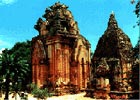 Eight Po Nagar Cham Towers were built on Cu Lao marble hill, 2 km north
of Nha Trang, between the 8th and 13th centuries.
Eight Po Nagar Cham Towers were built on Cu Lao marble hill, 2 km north
of Nha Trang, between the 8th and 13th centuries.
The largest of the four remaining towers was built in honour of Po Nagar,
also known as Lady Thien Y-ana or Goddess Mother; she spent part of her
life teaching new weaving and agricultural techniques. The 22.5 m tower
contains her sandstone statue sitting cross-legged on Buddha's throne.
The 2.6 m statue has ten hands, each holding a specific object illustrating
the intellect and power of Buddha. The remaining towers were dedicated
to different gods: the central tower to Cri Cambhu, the northwest tower
to Sandhaka and the south tower to Ganesha.
Not only are the towers famous for their architecture and sculpture,
but they are also well known for their great significance in history,
nationalism, and archaeology.
Standing on the top of the hill, one can admire the beautiful landscapes
of the coastal region of Nha Trang.
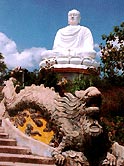 Long Son Pagoda is situated at the foot of Mount Trai Thuy, northwest
of Nha Trang, in Khanh Hoa province.
Long Son Pagoda is situated at the foot of Mount Trai Thuy, northwest
of Nha Trang, in Khanh Hoa province.
The pagoda was first built on Mount Trai Thuy in 1886 and named Dang Long
Pagoda. In 1900, the pagoda was damaged in a storm and was rebuilt down
the mountain in its present location. The Khanh Hoa Buddhist Studies Foundation
originated here in 1936. The pagoda underwent further restorations in
1940, 1971, and 1975.
Among the interesting things to see is the naturally lit image of Buddha
displayed in this pagoda. There is also the 14-m red brass statue of Buddha
sitting on a lotus pedestal.
This pagoda was built to commemorate the monks and nuns who died while
fighting against the Diem government.
Ha Tien [South] Best Dec-
May
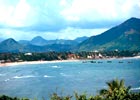 The coastline of Ha Tien is on the border with Cambodia [5m/9 km] and
has some superb beaches, including the site of the French film L'amant
[The Lover, 1995].
The coastline of Ha Tien is on the border with Cambodia [5m/9 km] and
has some superb beaches, including the site of the French film L'amant
[The Lover, 1995].
Hon Chong Beach is a very seductive beach with soft white sand and calm
tropical water, while nearby Tien Cave has interesting rock formations.
White sandy Duong Beach is also worth a try.
The Hai Tac islets accessible by boat from Ha Tien offer some great diving
for scuba freaks. The biggest of these islands, Hon Doc, has also some
splendid white beaches. Or try Nghe Island [1 hour one way].
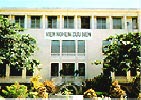 Marine research institute was previously the oceanography institute founded
in 1923, which is situated on a large area alongside Cau Da, 6 km away
from Nha Trang.
Marine research institute was previously the oceanography institute founded
in 1923, which is situated on a large area alongside Cau Da, 6 km away
from Nha Trang.
Laboratories, libraries, warehouses... are designed as a spacious multi-storey
architecture, gracefully situated in the shade
of Blue Dragon (a kind of fruit). Marine creature museum in the institute
owns some 20,000 specimen of aquatic creatures and specially there is
a giant whalebone of 26 meter length, 3 meter height.
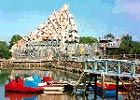 Palace of Ocean King is at the present the largest side nationwide, opened
in 1998 on Hon Mieu Island, close to Tri Nguyen fish lake.
Palace of Ocean King is at the present the largest side nationwide, opened
in 1998 on Hon Mieu Island, close to Tri Nguyen fish lake.
Palace of Ocean King was designed and constructed with the look of a
sailing yawn, allowing visitors to relax, to behold the live life of marine
royal and mermaids.
Here you can get an inkling of the work of one of Vietnam's greatest heroes,
expat or not. Swiss doctor Yersin founded Dalat, isolated a plague-causing
bacteria, and researched agricultural methods and meteorological forecasting,
all to the great benefit of the Vietnamese. He founded the institute in
1895. On display are his desk, overflowing library, and scientific instruments.
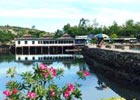 Location: South-east of Nha Trang city, on Hon Mieu Island. Also named
Bong Nguyen Island - Island of Immortals Distance from central Nha Trang:
7 kilometers.
Location: South-east of Nha Trang city, on Hon Mieu Island. Also named
Bong Nguyen Island - Island of Immortals Distance from central Nha Trang:
7 kilometers.
Tri Nguyen Aquarium was built in 1971, a highly inventive work of distinction,
by Le Can, a fisherman who was fond of nature very much with goodwill
and proud of his homeland. With his own money, he hired local inhabitants
to block the sea and build a dam for the construction of a large pond
160m in length and 130m wide.
The pond consists of three compartments, one for breeding savage fishes,
one for aquarium fishes, shrimps and turtles of different kinds and many
other species of sealife to breed in his aquarium.
Therefore, the aquarium creates a unique world of multifarious aquatic
animals, a living museum of the marine life in Nha Trang. This splendid
work is highly entertaining, for it has been much visited and lauded by
tourists from far and near. The sea-water has an easy circulation into
and out of the pond, for the banks were built of stones which had been
so cleverly arranged as to provide sufficient spaces for the water to
flow in and out, and thus providing sea conditions quite suitable to the
marine animals in the compartments.
From the Aquarium, a short walk up and down a small hill will take you
to a gravel beach (motor-boats are also available). The beach faces south-east,
Hon tam is in front and a little farther on are two other small islands,
Hon mot and Hon Mun. With the monsoon winds fanning all year round, there
are always fine weather here, and the sea is calm. The beach is really
ideal for holiday-makers; it is formed not by sand but fine layers of
pebbles and round-shaped cobblestones of various sizes, which are finely
mingled together, a splendid work achieved through ages of erosion by
the sea-waves...
At noon you can come into a gorge to have a rest out of the dazzling
sunshine. Or, in the shade of some overhanging branches of bush, you can
lie down, completely relaxed on a large and smooth stone-flat, amuse yourself
listening to the ever-lasting sounds of music coming from the sea. Certainly
you are having exquisite moments on your trip to this beautiful city.
The largest of the surrounding islands, Hon Mieu has a fishing
village, Bai Soi, that isn't very active any longer but features many
seafood restaurants. There is also an aquarium of sorts, consisting of
a lake divided into three sections: one for ornamental fish, one for edible
fish, and one for carnivorous varieties; there's a wharf to stand on.
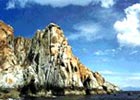 Salangane Island is most famous for Yen Sao which is the name of the nest
of Salangane or swifts. The locals harvest the bird nests (considered
a delicacy) used in soups. These nests are processed and exported to Taiwan
and Hong Kong.
Salangane Island is most famous for Yen Sao which is the name of the nest
of Salangane or swifts. The locals harvest the bird nests (considered
a delicacy) used in soups. These nests are processed and exported to Taiwan
and Hong Kong.
The birds build their nest high on the walls of the cave on the islands.
To access the nests, harvesters must climb on ladders fashioned from bamboo.
Because the caves must remain dark lest the birds are scared off, many
climbers fall to their death every year trying to harvest the nests.
The bird nest comes in two types, white and red nests. The nest are fashioned
by the Salangane that make their homes in caves. The nest are made out
of the bird's saliva. Usually, a typical bird creates one nest a year
during springtime using both parents saliva.
As there is such a demand for their nest (thought to have medicinal qualities),
the locals began to remove the nest several times a year causing the birds
to have to continue producing the nests.
The red variety of nests are a result of the birds having to create so
much saliva for the new nests that they cough up blood along with their
saliva causing the nest to take on the red color of their blood. This
variety of nest costs their weight in gold or more in the retail market
of Hong Kong or Taiwan.
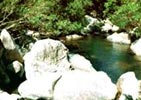 Ba Ho stream is 25 km from Nha Trang to the north. This is a stream originating
from the top of Hon Son (over 660m), flowing between the two sides of
the rocky mountains into the fields of Phu Huu hamlet, Ninh Ich village,
Ninh Hoa district, then pours into Nha Phu swamp. The stream gets its
name in its supper stream, on the way through the forests and mountains,
it opens three times in width right in the mountains into three continuous
lakes.
Ba Ho stream is 25 km from Nha Trang to the north. This is a stream originating
from the top of Hon Son (over 660m), flowing between the two sides of
the rocky mountains into the fields of Phu Huu hamlet, Ninh Ich village,
Ninh Hoa district, then pours into Nha Phu swamp. The stream gets its
name in its supper stream, on the way through the forests and mountains,
it opens three times in width right in the mountains into three continuous
lakes.
With its beautiful landscapes, the stream has been in many people's mouths
and mind and bears many legends told by the local people.
From Nha Trang, you can follow National Route 1A for 19 km, then 2 km
of forest lane after turning left. Walking along the stream, you will
soon reach the First Lake. The surface of the lake is about 150 m2, lying
below a cascade 5-6m high. Around the lake are numerous rocks of all sizes
and colors.Leaving the First Lake and continuing your way upstream, you
will reach the Second Lake after making your way quite difficulty for
1,000m.
Unlike he First Lake, the Second Lake is narrower and milder, but with
more "fairy" features due to its quietness. The lake is formed
by a big flat rock lying across the stream. The surface of the lake is
always tranquil like a huge mirror left behind by the fairies.
The Third Lake is only a few hundred meters from the Second Lake, but
the way is covered with bushes and is a little challenging to visitors.
The Third Lake is narrower than the two others but its bed is wider, lying
at the foot of a small cascade beside a rock wall with many tree roots
and rampant vegetation. But here, visitors may find in the age-old trees
by the lake orchids giving out their sweet and soft fragrance among the
twittering sounds of myriads of strange birds.
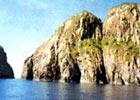 From the gravel beach of Hon Mieu, you will see three small islands lying
in a row; they are Hon Tam, Hon Mot and Hon Mun; among these, Hon Mun
has a most attractive landscapes.
From the gravel beach of Hon Mieu, you will see three small islands lying
in a row; they are Hon Tam, Hon Mot and Hon Mun; among these, Hon Mun
has a most attractive landscapes.
Its name derives from the geographical features - the high cliffs in the
southwest are too risky, ragged with numerous caves; here rocks and stones
are all ebony-like black, which is rarely found on any other islands.
It is also one of the seven islands in the Nha Trang sea that attract
thousands of salanganes to come and build their nests, which give thousands
of tai, i.e products from their nests every year.
Like Bai Tru, the beach at Hon Mun does not have that kind of while fine-grained
sand, and its formation and composition are much like the gravel beach
at Tri Nguyen, the island of the Immortals, with layers of round-shaped
pebbles and cobbles closely arranged by Nature's hand.
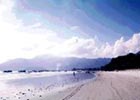 The place gets its Vietnamese name of Doc Let because if you want to reach
to the sea, you have to cross high sand dunes and if you are not strong
enough, the sand would seem to hold you back and quite a few people to
lag ("let" in Vietnamese) to the destination. However, there
is a great compensation for you once you have finished your conquer of
the dunes.
The place gets its Vietnamese name of Doc Let because if you want to reach
to the sea, you have to cross high sand dunes and if you are not strong
enough, the sand would seem to hold you back and quite a few people to
lag ("let" in Vietnamese) to the destination. However, there
is a great compensation for you once you have finished your conquer of
the dunes.
In front of you now would be a wonderful beach with fine, smooth, and
pures and the blue sea with tiny waves. The sand beach runs as far as
10km from Dong Hai Village to the Cement Factory of Hon Khoi.
Doc Let is not only an ideal swimming beach, but its natural landscape
is also quite attractive to tourists. Islands of every sizes and shapes
off shore into two bows hindering the wave. The big island from afar looks
like a sunbathing girl.
Not far to the north is the famous Van Phong Bay, one of the future tourist
spots that the international Tourism Organization OMT has surveyed and
highly assessed the future development of tourism of the area.
To the south, beyond the Cement Factory is Hon Heo, the former revolutionary
base with so many heroic exploits that have not noted down in history.
Also, only 2-3 kilometres from Doc Let, tourists can visit the fishing
village of Ninh Thuy, the salt fields of Ninh Diem or take a rest in the
shade of the coconut palms and poplars or at windy shops beautifully decorated
for a drink and other sea specialities such as fresh crabs, sentinel crabs,
oysters,...at their own will.
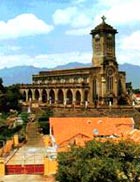 The construction of Nha Trang Main Cathedral was started on Sep 3, 1928.
Archbishop Louis Vallet had the top of the mountain blown off with 500
mines to obtain a flat surface of 4,500 m2.
The construction of Nha Trang Main Cathedral was started on Sep 3, 1928.
Archbishop Louis Vallet had the top of the mountain blown off with 500
mines to obtain a flat surface of 4,500 m2.
In March 1934, the colorful windows were fixed into the domed doors and
in the cathedral, completing more than ten construction items. Three big
bells were supplied by the famous Bourdons Carillons company (established
in 1786) and were christened in July 1934 and in October 1939. The big
clock on the top of the cathedral was inaugurated in December 1935.
The cathedral was built with steel reinforced concrete with walls in
top quality cement slabs. In general, the construction has a solid and
strong structure with details getting smaller as they climb up the building.
The highest point is the place where the cross is fixed on the top of
the church: 38 m from the surface of the street below. Although it was
built nearly 70 years ago, the cathedral keeps its majestic beauty and
its unique architecture.
|
|
 |
Travel
Guides |
|
|
 |
|

